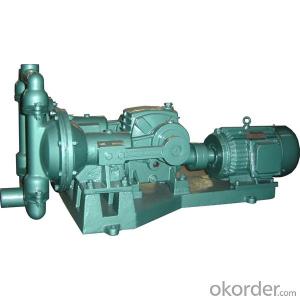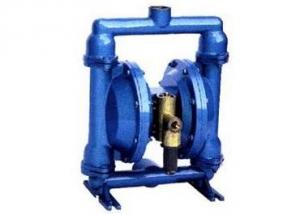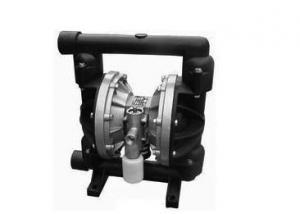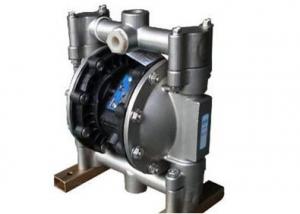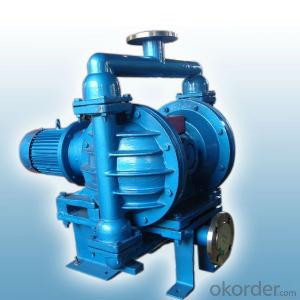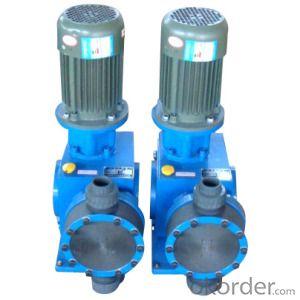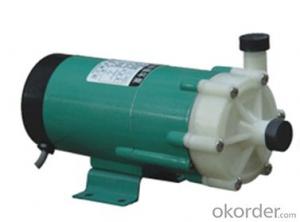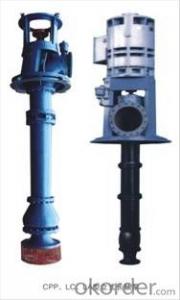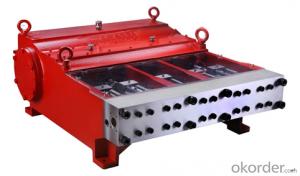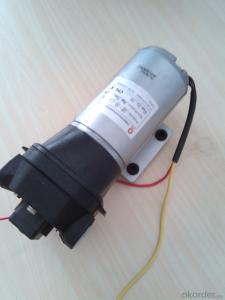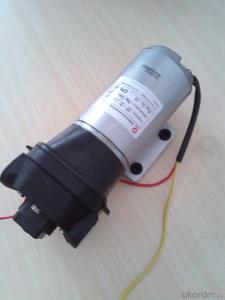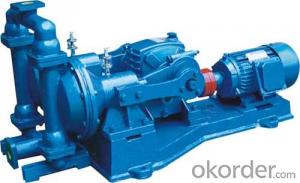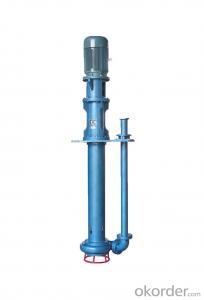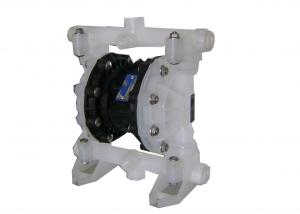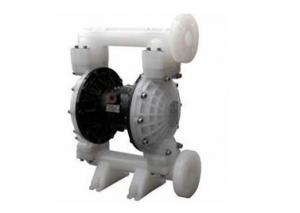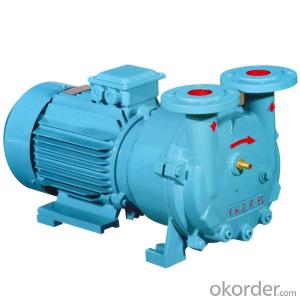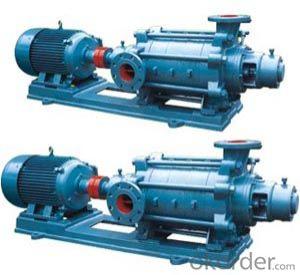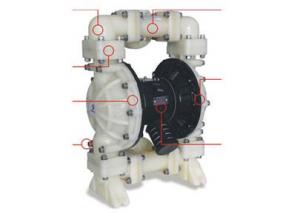Electric Motor diaphragm dose pump
- Loading Port:
- China Main Port
- Payment Terms:
- TT OR LC
- Min Order Qty:
- -
- Supply Capability:
- -
OKorder Service Pledge
OKorder Financial Service
You Might Also Like

Product description:
This series of diaphragm pump is a latest model now at home. It is suitable for various corrosive,highly viscid, volatile, inflammable, explosive and virulent liquid, liquid containing grains, enamel slurry, mashed fruit and glue, and can pump completely in the recovery of bottom oil in oil tankers and temporary tank emptying etc. Its performance parameters are close to Germany WLLDENPUMPS and US MARIOWPUMPS. The flow components in pump body are made of stainless steel, aluminum alloy or cast iron. Diaphragm can be made of NBR, VITON, CR or PTFE according to different liquid.
Pump Application:
Applicable to petroleum, chemical, ceramic, metallurgy industrials, take copy of USA ABEL company, operated at low pressure, below 3 bar.
1.kind of poisonous, flammable, volatile liquid.
2.strong acid, alkali, corrosive liquid.
3.high temperature media, up to 150deg.C.
4.increase pressure for filter press.
5.hot water recycle and circulation.
6.delivery oil for oil tank truck,oil storage.
7.suck pickled vegetables, sauce, mashed potato, chocolate,etc.
8.paint,gum,adhesive
9.mud slurry,cement, mortar.
10.rubber slurry, organic solvent, stuffing.
11.clearance sewage and balance oil for tanker, barge
12.beer, syrup, ferment food slurry
13.other special media
Technical Data:
Flow rate: up to 20 m³/h
Head: up to 30 m
Speed: max 1450 rpm
Temperature: max 150 °C
Casing pressure: up to 3 MPa
Shaft seal: mechanical sealing
Material: nodular iron, stainless steel, duplex
- Q: Can an air pump be used for inflatable gardening tools?
- Yes, an air pump can be used for inflatable gardening tools. Inflatable gardening tools such as inflatable planters, gardening cushions, or even inflatable greenhouses can be easily inflated using an air pump. The air pump provides a quick and efficient way to inflate these tools, making them ready for use in a matter of minutes. It is important to ensure that the air pump is compatible with the type of valve used in the gardening tool to ensure a proper fit and inflation.
- Q: Can an air pump be used for filling up oxygen tanks?
- An air pump is not suitable for filling up oxygen tanks. Air pumps are designed to compress and pump regular air, which contains about 21% oxygen along with nitrogen and trace amounts of other elements. On the contrary, oxygen tanks are specifically designed to store and contain pure oxygen. Pure oxygen is utilized for diverse medical purposes and must be kept at high pressure to ensure its availability in emergencies or for patients with respiratory conditions. Consequently, specialized equipment like oxygen concentrators or oxygen compressors is required to safely and efficiently fill up oxygen tanks with pure oxygen.
- Q: Can an air pump be used for inflatable art installations?
- Yes, an air pump can definitely be used for inflatable art installations. In fact, it is one of the most common and efficient tools used for inflating large-scale art installations. The air pump provides a steady and controlled flow of air into the installation, allowing it to be fully inflated and maintain its desired shape. Depending on the size and complexity of the installation, different types of air pumps may be used, such as electric or manual pumps. Additionally, air pumps can be equipped with various attachments and nozzles to fit different types of valves and ensure a secure and airtight inflation. So, whether it's a giant balloon sculpture, an inflatable installation, or any other type of inflatable art, an air pump is an essential tool for bringing it to life.
- Q: Can an air pump be used for inflating air mattresses with built-in temperature control?
- Indeed, an air pump is capable of inflating air mattresses equipped with built-in temperature control. The main purpose of an air pump is to supply air to the mattress, regardless of any supplementary features such as temperature regulation. The temperature control mechanism integrated within the air mattress is an independent system that manages the air temperature within the mattress. The air pump's duty is solely to inflate the mattress, whereas the temperature control system ensures comfort by adjusting the air temperature. Consequently, one can certainly utilize an air pump to inflate an air mattress equipped with built-in temperature control.
- Q: What are the common problems or malfunctions in air pumps?
- Air pumps can encounter several common problems or malfunctions. One prevalent issue involves a clogged or blocked air intake or outlet, which can be caused by debris or dirt becoming trapped in the pump and obstructing the air flow. Another problem that arises frequently is a worn-out or damaged diaphragm or piston seal. These components can become brittle or develop cracks over time, resulting in air leaks or a decrease in pumping efficiency. Another typical problem involves a malfunctioning check valve. This valve is responsible for preventing air from flowing back into the pump, ensuring that it only moves in one direction. If the check valve becomes faulty, it can cause air to escape back into the pump, thereby reducing its effectiveness. Furthermore, air pumps may experience failures with their motors or encounter electrical issues, such as burned-out motors or faulty wiring connections. These problems can prevent the pump from turning on or supplying sufficient air pressure. Lastly, air pumps can suffer from overheating. This can happen if the pump operates continuously for extended periods without proper ventilation or if it is overloaded beyond its capacity. Overheating can result in damage to internal components and cause the pump to malfunction or cease functioning altogether. To prevent or mitigate these common problems, regular maintenance, including cleaning and lubricating the pump, is recommended. However, if any of these malfunctions occur, it is advisable to seek assistance from a professional or contact the manufacturer for guidance on resolving the issue.
- Q: Are air pumps suitable for inflating air pillows?
- Air pumps are indeed appropriate for inflating air pillows. They offer a convenient and effective means of inflating air pillows, effortlessly and swiftly filling them with the required amount of air. By doing so, they guarantee that the air pillow achieves the desired level of inflation, ensuring optimum comfort and support. Furthermore, the use of an air pump eradicates the need for manual blowing, which can be a tedious process and may not yield consistent inflation. In general, air pumps are a dependable and pragmatic tool for inflating air pillows.
- Q: How loud is an air pump when in operation?
- The loudness of an air pump during operation can differ based on various factors. In general, air pumps generate noise due to mechanical parts and air movement. The noise level can range from a low hum to a noticeable buzzing sound. The loudness is also affected by the size and power of the air pump. Bigger and more powerful pumps tend to produce higher levels of noise compared to smaller and less powerful ones. Moreover, the type of air pump can also impact the noise level. For instance, diaphragm pumps are typically quieter than piston pumps. However, it is important to note that the noise level of an air pump is generally not excessive or disruptive. Most air pumps are designed to operate at reasonable noise levels, especially those intended for home aquariums or small applications. Nevertheless, it is advisable to consider noise levels when selecting an air pump, particularly if you plan to use it in a quiet environment or during nighttime when noise sensitivity may be heightened. Ultimately, the loudness of an air pump is subjective and can vary from person to person. It is recommended to check the manufacturer's specifications or reviews to gain a better understanding of the noise level before purchasing an air pump.
- Q: Are air pumps suitable for inflating air mattresses for hospitals?
- Air pumps are indeed appropriate for inflating air mattresses in hospitals. These types of mattresses are commonly utilized in healthcare settings to offer comfort and assistance to patients who are confined to bed or have limited mobility. The purpose of these mattresses is to be filled with air, creating a cushioning effect that prevents bedsores and encourages the healing process. Air pumps are specifically designed to inflate air mattresses quickly and efficiently, guaranteeing that patients can receive the necessary support and comfort they require. Moreover, air pumps often come with adjustable pressure settings, allowing healthcare professionals to customize the firmness of the mattress according to the patient's specific needs. Consequently, air pumps are a sensible and practical tool for inflating air mattresses in hospitals.
- Q: What is the main function of the air pump in the sauce packing machine? Can it be packed without an air pump?
- No cylinder can, vertical is generally not required!
- Q: An air pump is not switched on and the voltage is normal
- After the motor is energized, the following reasons may not be possible:1, power supply missing phase, including switch or contactor, at least one phase contact bad or broken line, at this time the motor will have buzz.2. If there is no movement, check to see if the electricity is delivered;3, whether the mechanical part of the locking conditions, limit start, etc..
Send your message to us
Electric Motor diaphragm dose pump
- Loading Port:
- China Main Port
- Payment Terms:
- TT OR LC
- Min Order Qty:
- -
- Supply Capability:
- -
OKorder Service Pledge
OKorder Financial Service
Similar products
Hot products
Hot Searches
Related keywords
